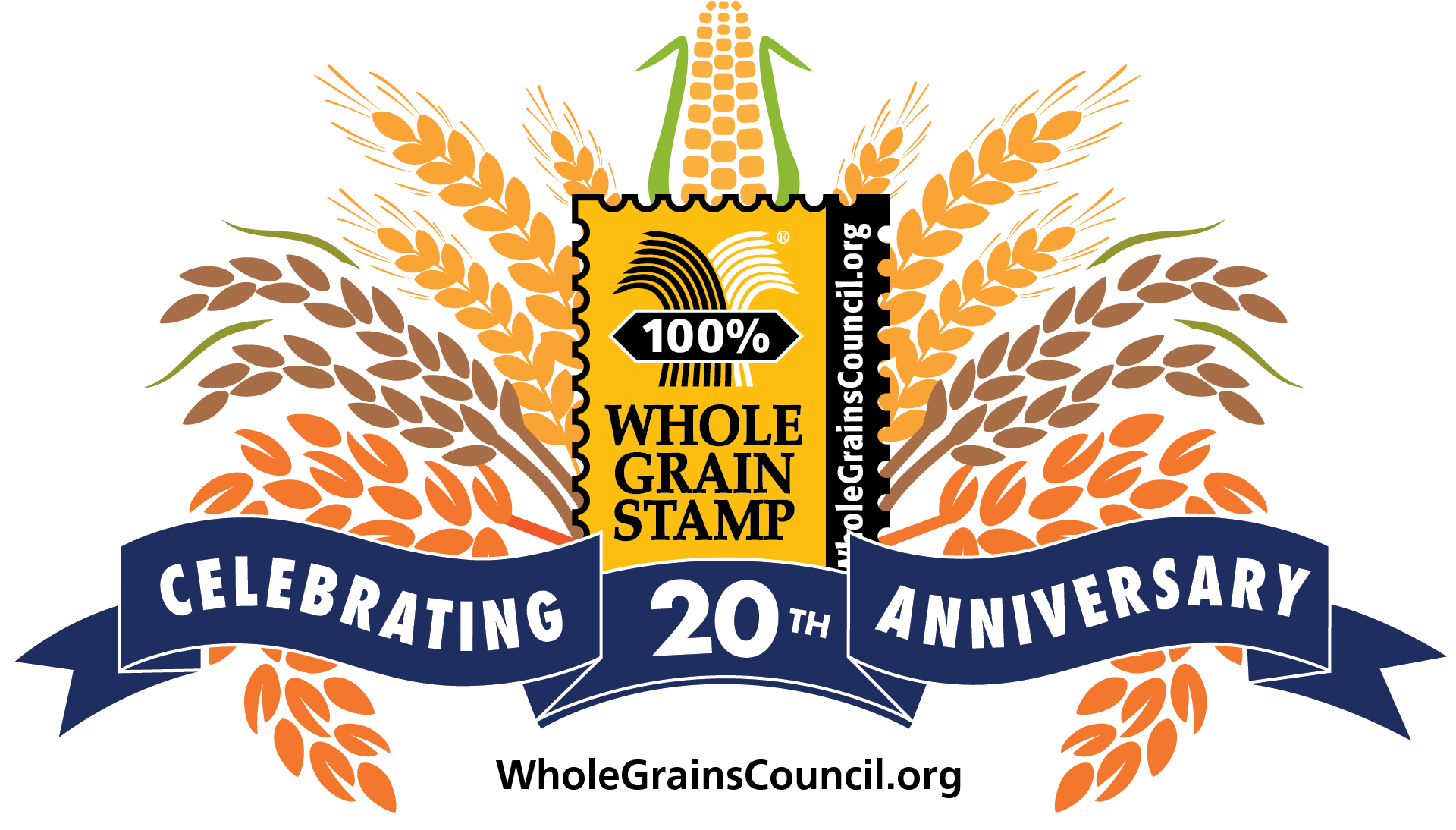Share This
We’re celebrating a very special anniversary this month! In January 2005, the Whole Grain Stamp officially launched, beginning our journey to 342 member companies with 12,000+ stamped products in 65 countries. To celebrate, we’re running a social media and blog series about the launch of the Stamp. First, we spoke with some of our founding member companies about our 20 years of partnership, how the whole grain landscape has changed, and what the Whole Grain Stamp means to them.
WGC: How has consumer enthusiasm for whole grain products changed over the past 20 years?
Sunnyland Mills: Yes, we have definitely seen increased awareness of whole grains since the early days of the WGC! Now people requesting information can clearly see that our products are whole grain, and are driven by that attribute.
Lotus Foods: Over the past 20 years, consumer enthusiasm for whole grain products has grown significantly, driven by increasing awareness of their health benefits and the rising demand for more nutritious, sustainable food options. Initially, whole grains were often seen as niche products reserved for health-conscious individuals or specialty stores. However, as research has increasingly highlighted the benefits of whole grains—such as their role in reducing the risk of heart disease, supporting digestion, and managing weight—more mainstream consumers have embraced them. We have also seen a rise in dietary restrictions and preferences like gluten-free and plant-based that has allowed many of our consumers to embrace and elevate whole grains as part of their diet. We are proud to be a pioneer of making whole grains more accessible and appealing through innovative ramen, rice noodles and heirloom rice varieties.
USA Rice: There has been a monumental shift toward whole grains, and it has been fascinating to watch. What once was considered niche or reserved for just the super health-conscious consumer is now completely mainstream with consumers turning to whole grains as a first choice and restaurants ranging from fast casual to fine dining menuing whole grains. Year over year, we see growth for whole grains as the initial hesitancy or barrier to access has dissipated and consumers turn to whole grains for a variety of reasons beyond just its nutritional profile, which is incredible and a testament to the progress whole grains have made over the last 20 years.
United Sorghum Checkoff Program: Human consumption of sorghum has skyrocketed, increasing by more than 250% over the past decade, accompanied by a surge in sorghum-based products hitting the market. From baby and toddler puffed snacks to cereals and premium ice creams, Americans are embracing the versatility and nutrition of sorghum.
WGC: Do you have a favorite way to eat whole grains? Are there any culinary tips or recipes you want to share?
Sunnyland Mills: I like to “Eat whole grains at every meal” because of the impactful messaging that the WGC used years ago. Specifically, Whole grain cereal in the morning, a whole grain bread at lunch and whole grain pasta or a bulgur pilaf at dinner. I add bulgur wheat to my oatmeal, with tabouli salad, or in almost any soup or salad. I especially like to add bulgur to beans in a dish for a boost in nutrition by forming a complete protein.
Lotus Foods: We may be biased, but we have a growing love for noodle-based meals featuring whole grains, as they offer a tasty and versatile way to get a serving of fiber, antioxidants, and essential nutrients. One of our favorite ways to enjoy whole grains is by using whole grain noodles in dishes that are both comforting and nourishing. Lotus Foods has a wide range of noodles, from the fan favorite Millet & Brown Rice Ramen to the trendy Buckwheat & Brown Soba Noodles, and Brown Udon Noodles. Each of these noodles brings a unique flavor and texture to the table.
A quick and satisfying dish I often prepare is a simple noodle bowl: just cook your noodles according to the package instructions, then toss with a savory broth, fresh veggies, and a sprinkle of sesame seeds. Add a boiled egg or a drizzle of soy sauce, and you’ve got a quick, wholesome meal that’s rich in whole grains. The great thing about these noodles is how well they absorb the flavors of the broth, making them the perfect canvas for your favorite seasonings and toppings.
USA Rice: Oh, my favorite way to eat whole grains is by first diversifying my whole grain intake! Consumers crave different textures and colors, and whole grains definitely deliver on that. That means cooking with not just brown rice, but trying purple, red, black and wild rice. USA Rice has a Philly Cheesesteak Stuffed Peppers recipe that is loved in my house, followed by wild rice burgers, and rounded out by purple rice sushi. Yum!
My biggest tip is to not be afraid to experiment! Keep in mind the additional cook time, but beyond that whole grain rice will work for any recipe that calls for milled rice so don’t be afraid to make swaps and add whole grains to your favorite recipes.
WGC: How has the Whole Grain Stamp helped your company gain recognition and trust?
Sunnyland Mills: We’ve seen clear benefit in our consumers! We know how much people trust the Stamp, and on our products it assures consumers that the bulgur is a 100% whole grain ingredient.
Lotus Foods: The Whole Grain Stamp has played a pivotal role in helping our company gain recognition and trust, especially as consumer interest in whole grains has grown. By featuring the Stamp on our products, we clearly communicate our commitment to providing authentic whole grain options that meet the rigorous standards set by the Whole Grains Council. This certification not only assures consumers that they are choosing products with genuine whole grains but also aligns our brand with trusted values of transparency, quality, and nutrition.
The Whole Grain Stamp acts as a badge of credibility in a crowded marketplace, where consumers are increasingly cautious about product claims. It helps distinguish our products from those made with refined grains. Beyond consumer recognition, the Stamp has also helped us build stronger relationships with retail partners. Many stores actively prioritize stocking products with the Whole Grain Stamp, knowing it resonates with health-conscious shoppers.
USA Rice: The Whole Grain Stamp almost has universal recognition and tells each and every consumer that what they are holding or just purchased is a high-quality whole grain product. The Stamp facilitates trust among shoppers which is a very important and beautiful thing these days. Front of package labeling should be direct and easy to understand and the Whole Grain Stamp is a pioneer of that.
WGC: Finally, Can you share some memories about the early days of the Whole Grains Council and the Stamp?
Sunnyland Mills: Lots of fun memories in the early days with Oldways founder Dun K. Gifford, Oldway’s President Sara Baer-Sinnott and the Stamp creator Cynthia Harriman! Pouring a bowl of bulgur wheat over Dun’s head and anointing him the King of Whole Grains was memorable, as was the fun we had at a piano bar in New Orleans during the first WGC conference. As I look back, I remember how we nervously wondered if anyone would show up at our first meetings after we cold called them and asked/begged them to attend. When they did and in greater numbers than we expected we knew that we were on to something. We first commissioned the name “Whole Grains Council” by clinking our wine glasses together at a Mediterranean Diet conference, motivated by dispelling the myths of low-fat and low-carb fad diets.
Lotus Foods: Yes! Since Lotus Foods were pioneers in introducing pigmented whole grain rice like the black Forbidden Rice® and the Bhutanese Red Rice to the American market, we were grateful to the pioneering work of Cynthia Harriman and her colleagues at Oldways. It was really their commitment and passion that got the Whole Grain Stamp to become so widely accepted.
To have our Oldways Whole Grains Council blog posts (and more whole grain bonus content!) delivered to your inbox, sign up for our monthly email newsletter, called Just Ask for Whole Grains.



Add a Comment